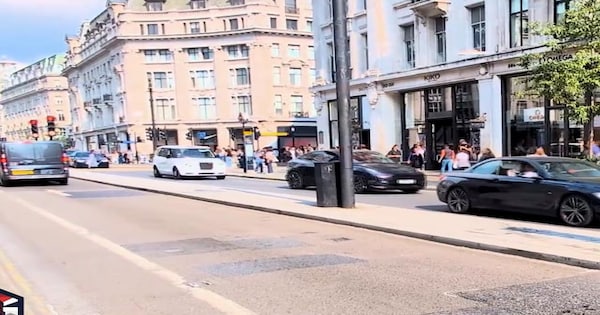– What are the potential environmental benefits of the traffic ban on Oxford Street in London?
London’s Traffic Ban on Oxford Street: Impact on the British Economy
London’s iconic Oxford Street has implemented a traffic ban in an effort to reduce pollution and congestion in the area. This move has significant implications for the British economy, affecting businesses, consumers, and the overall commercial landscape of one of the world’s most famous shopping destinations. Let’s explore what the traffic ban on Oxford Street means for the British economy.
Impact on Retail and Hospitality Industries
The traffic ban on Oxford Street is expected to have a notable impact on the retail and hospitality industries in the area. With less congestion and pollution, businesses will be able to offer a more pleasant shopping and dining experience, attracting more visitors and potentially increasing sales. Additionally, the ban could lead to a rise in foot traffic, benefiting retailers and restaurants along Oxford Street.
Furthermore, the improved air quality resulting from the traffic ban can create a healthier environment for both employees and customers, which can have a positive effect on employee productivity and customer satisfaction. This, in turn, can contribute to the overall economic growth of the area.
Reduced Pollution and Environmental Benefits
The traffic ban on Oxford Street aims to reduce pollution and improve air quality in the heart of London. By significantly decreasing the levels of traffic-related emissions, the ban has the potential to deliver substantial environmental benefits, including lower levels of air pollution and reduced carbon emissions. This is not only advantageous for public health but also aligns with the UK’s commitment to sustainability and environmental responsibility.
Improved air quality can have a direct impact on public health, resulting in lower healthcare costs and improved productivity among residents and workers in the area. Additionally, a cleaner and more appealing environment can enhance the overall attractiveness of Oxford Street as a destination for tourists and locals alike, which can benefit the British economy through increased tourism and consumer spending.
Challenges and Adjustments for Businesses
While the traffic ban on Oxford Street carries several potential benefits, it also presents challenges and adjustments for businesses in the area. Retailers and hospitality establishments may need to adapt their logistics and delivery operations to comply with the traffic restrictions. This could involve revising delivery schedules, exploring alternative transportation methods such as electric or cargo bikes, or optimizing supply chain management to minimize disruptions caused by the ban.
Additionally, businesses on Oxford Street may need to rethink their marketing and promotional strategies to capitalize on the anticipated increase in foot traffic and consumer engagement resulting from the traffic ban. Adapting to the changing landscape and consumer behavior can be key to maintaining a competitive edge and maximizing the economic opportunities brought about by the ban.
Economic Growth and Regeneration
Ultimately, the traffic ban on Oxford Street reflects a broader vision for economic growth and urban regeneration in London. By reimagining the commercial landscape of Oxford Street as a pedestrian-friendly, environmentally conscious hub, the ban aligns with urban development goals and aspirations for sustainable, inclusive economic growth.
This move can enhance the overall attractiveness of Oxford Street as a vibrant, modern destination for retail, dining, and leisure, fostering a more appealing environment for both businesses and consumers. The potential economic benefits may extend beyond the immediate vicinity of Oxford Street, influencing the broader economy and contributing to London’s ongoing urban development and revitalization efforts.
Conclusion
The traffic ban on Oxford Street in London is poised to have a profound impact on the British economy, influencing retail, hospitality, environmental sustainability, and urban regeneration. While the ban presents challenges for businesses, it also offers opportunities for growth, innovation, and economic revitalization. As London continues to prioritize sustainability and urban development, the traffic ban on Oxford Street represents a significant step towards shaping a more vibrant and economically thriving commercial landscape in the heart of the city.
The Impact of Oxford Street Traffic Ban on London’s Economy and Local Residents
London, the most visited city in the United Kingdom, attracts over half a million visitors daily for shopping, dining, and leisure activities. The recent announcement by Mayor Sadiq Khan to ban traffic on Oxford Street has sparked discussions about its potential impact on the economy, nearby shops, and local residents. This move is not only significant for the city but also holds particular relevance for British Indian residents living in the vicinity.
Economic Implications
The ban on traffic at Oxford Street could have significant economic implications. With an estimated 500,000 daily visitors to the area, transportation restrictions may impact businesses reliant on foot traffic. As a result of reduced accessibility and potential changes in consumer behavior patterns due to altered convenience levels when visiting stores or restaurants along this famous shopping street.
Local Shops and Businesses
The move to ban traffic at Oxford Street may have varying impacts on local shops and businesses. On one hand, it could lead to decreased footfall if potential customers are deterred by restricted access; however, it might also encourage more pedestrian activity if people feel safer walking around without having to contend with vehicular traffic.
British Indian Community Perspectives
For the British Indian community residing near Oxford Street, this decision could hold particular significance. It may affect their daily routines as they navigate through possible changes in transportation routes or modes. Furthermore which could benefit from reduced vehicular congestion that has been a long-standing issue in this area.
Conclusion:
The proposed ban on traffic at Oxford Street carries implications beyond mere logistical rearrangements: its effects will reverberate through various spheres ranging from economics-to-ethnic communities around it while leaving tangible impacts upon lifestyle habits of diverse groups within London’s bustling urban landscape.


